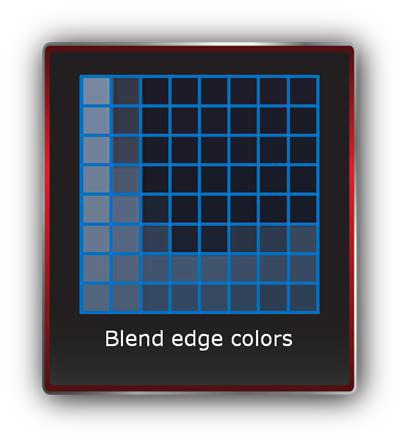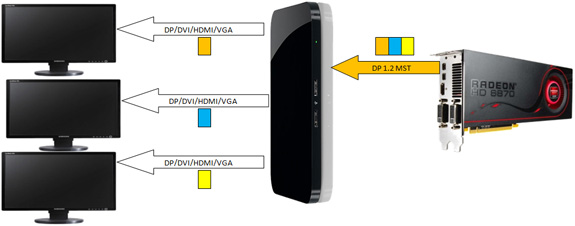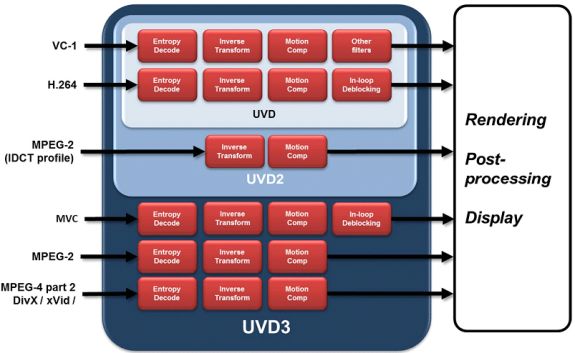AMD's Radeon HD 6970 & Radeon HD 6950: Paving The Future For AMD
by Ryan Smith on December 15, 2010 12:01 AM ESTRefresher: The 6800 Series’ New Features
Back in October AMD launched the first 6000 series cards, the Barts-based Radeon HD 6800 series. At their core they are a refreshed version of the Cypress GPU that we saw on the 5800 series, but AMD used the opportunity to make some enhancements over the standard Cypress. All of these enhancements apply throughout the 6000 series, so this includes the 6900 series. As such for those of you who didn’t pay much attention to the 6800 series, we’re going to quickly recap what’s new in order to lay the groundwork for further comparisons of the 6900 series to the 5800 series.
We’ll start with the core architecture. Compared to Cypress, Barts is nearly identical save 1 difference: the tessellator. For Barts AMD implemented what they call their 7th generation tessellator, which focused on delivering improved tessellation performance at lower tessellation factors that AMD felt were more important. Cayman takes this one step further and implements AMD’s 8th generation tessellator, which as the naming conventions implies is the 7th generation tessellator with even further enhancements (particularly those necessary for load balancing).
The second change we saw with Barts and the 6800 series was AMD’s refined texture filtering engine. AMD’s texture filtering engine from the 5800 set new standards by offering angle independent filtering, but it had an annoying quirk with highly regular/noisy textures where it didn’t do a good enough job blending together various mipmaps, resulting in visible transitions between them. For the 6800 series AMD fixed this, and it can now properly blend together noisy textures. At the same time in a controversial move AMD tweaked its default filtering optimizations for the 5800 series and entire 6000 series, leading to these cards producing imagines subtly different (and depending on who you ask, subtly worse) than they were on the 5800 series prior to the Catalyst 10.10 drivers.

| Radeon HD 5870 | Radeon HD 6870 | GeForce GTX 480 |
The third change we saw was the introduction of a new anti-aliasing mode, initially launched on the 6800 series and backported to the 5800 series shortly thereafter. Morphological Anti-Aliasing (MLAA) is a post-processing filter that works on any (and all) images, looking for high contrast edges (jaggies) and blending them to reduce the contrast. Implemented as a compute shader, it works with all games. As it’s a post-processing filter the results can vary – the filter has no knowledge of depth, polygons, or other attributes of the rendered world beyond the final image – so it’s prone to blending everything that looks like aliasing. On the plus side it’s cheap to use as it was originally designed for consoles with their limited resources, so by not consuming large amounts of memory & memory bandwidth like SSAA/MSAA it usually has a low performance hit.


Last but not least, AMD made a number of changes to their display hardware. The Universal Video Decoder (UVD) was upgraded to version 3, bringing full decode support for MPEG-2, MPEG-4 ASP, and H.264 MVC (packed frame video for 3D movies). For the 6900 series this is not of great importance as MPEG-2 and MPEG-4 ASP are low complexity codecs, but it does play an important role for AMD’s future APU products and low-end GPUs, where offloading these low complexity codecs is still going to be a big relief for the slower CPUs they’re paired with. And on that note the first public version of the DivX codec with support for UVD3 will be shipping today, letting 6800/6900 series owners finally take advantage of this functionality.
The second of the major display changes was the addition of support for the DisplayPort 1.2 standard. DP1.2 doubles DisplayPort’s bandwidth to 21.6Gbps, finally giving DisplayPort a significant bandwidth lead over dual-link DVI. With double the bandwidth it’s now possible to drive multiple monitors off of a single root DisplayPort, a technology called Multi Stream Transport (MST). AMD is heavily banking on this technology, as the additional bandwidth coupled with the fact that DisplayPort doesn’t require a clock source for each monitor/stream means AMD can drive up to 6 monitors off of a single card using only a pair of mini-DP ports. AMD is so cutting edge here that like the 6800 series the 6900 series is technically only DP1.2 ready – there won’t be any other devices available for compliance testing until 2011.

Finally, the 6800 series also introduced support for HDMI 1.4a and support for color correction in linear space. HDMI 1.4a support is fairly straightforward: the 6000 series can drive 3D televisions in either the 1080p24 or 720p60 3D modes. Meanwhile support for color correction in linear space allows AMD to offer accurate color correction for wide gamut monitors; previously there was a loss of accuracy as color correction had to be applied in the gamma color space, which is only meant for use for display purposes. This is particularly important for integrating wide gamut monitors in to traditional gamut workflows, as sRGB is misinterpreted on a wide gamut monitor without color correction.
While all of these features were introduced on the 6800 series, they’re fundamental parts of the entire 6000 series, meaning they’re part of the 6900 series too. This provides us with a baseline set of improvements over AMD’s 5800 series, on top of the additional improvements Cayman and AMD’s VLIW4 architecture brings.











168 Comments
View All Comments
AnnonymousCoward - Wednesday, December 15, 2010 - link
First of all, 30fps is choppy as hell in a non-RTS game. ~40fps is a bare minimum, and >60fps all the time is hugely preferred since then you can also use vsync to eliminate tearing.Now back to my point. Your counter was "you know that non-AA will be higher than AA, so why measure it?" Is that a point? Different cards will scale differently, and seeing 2560+AA doesn't tell us the performance landscape at real-world usage which is 2560 no-AA.
Dug - Wednesday, December 15, 2010 - link
Is it me, or are the graphs confusing.Some leave out cards on certain resolutions, but add some in others.
It would be nice to have a dynamic graph link so we can make our own comparisons.
Or a drop down to limit just ati, single card, etc.
Either that or make a graph that has the cards tested at all the resolutions so there is the same number of cards in each graph.
benjwp - Wednesday, December 15, 2010 - link
Hi,You keep using Wolfenstein as an OpenGL benchmark. But it is not. The single player portion uses Direct3D9. You can check this by checking which DLLs it loads or which functions it imports or many other ways (for example most of the idTech4 renderer debug commands no longer work).
The multiplayer component does use OpenGL though.
Your best bet for an OpenGL gaming benchmark is probably Enemy Territory Quake Wars.
Ryan Smith - Wednesday, December 15, 2010 - link
We use WolfMP, not WolfSP (you can't record or playback timedemos in SP).7Enigma - Wednesday, December 15, 2010 - link
Hi Ryan,What benchmark do you use for the noise testing? Is it Crysis or Furmark? Along the same line of questioning I do not think you can use Furmark in the way you have the graph setup because it looks like you have left Powertune on (which will throttle the power consumption) while using numbers from NVIDIA's cards where you have faked the drivers into not throttling. I understand one is a program cheat and another a TDP limitation, but it seems a bit wrong to not compare them in the unmodified position (or VERBALLY mention this had no bearing on the test and they should not be compared).
Overall nice review, but the new cards are pretty underwhelming IMO.
Ryan Smith - Thursday, December 16, 2010 - link
Hi 7Enigma;For noise testing it's FurMark. As is the case with the rest of our power/temp/noise benchmarks, we want to establish the worst case scenario for these products and compare them along those lines. So the noise results you see are derived from the same tests we do for temperatures and power draw.
And yes, we did leave PowerTune at its default settings. How we test power/temp/noise is one of the things PowerTune made us reevaluate. Our decision is that we'll continue to use whatever method generates the worst case scenario for that card at default settings. For NVIDIA's GTX 500 series, this means disabling OCP because NVIDIA only clamps FurMark/OCCT, and to a level below most games at that. Other games like Program X that we used in the initial GTX 580 article clearly establish that power/temp/noise can and do get much worse than what Crysis or clamped FurMark will show you.
As for the AMD cards the situation is much more straightforward: PowerTune clamps everything blindly. We still use FurMark because it generates the highest load we can find (even with it being reduced by over 200MHz), however because PowerTune clamps everything, our FurMark results are the worst case scenario for that card. Absolutely nothing will generate a significantly higher load - PowerTune won't allow it. So we consider it accurate for the purposes of establishing the worst case scenario for noise.
In the long run this means that results will come down as newer cards implement this kind of technology, but then that's the advantage of such technology: there's no way to make the card louder without playing wit the card's settings. For the next iteration of the benchmark suite we will likely implement a game-based noise test, even though technologies like PowerTune are reducing the dynamic range.
In conclusion: we use FurMark, we will disable any TDP limiting technology that discriminates based on the program type or is based on a known program list, and we will allow any TDP limiting technology that blindly establishes a firm TDP cap for all programs and games.
-Thanks
Ryan Smith
7Enigma - Friday, December 17, 2010 - link
Thanks for the response Ryan! I expected it to be lost in the slew of other posts. I highly recommend (as you mentioned in your second to last paragraph) that a game-based benchmark is used along with the Furmark for power/noise. Until both adopt the same TDP limitation it's going to put the NVIDIA cards in a bad light when comparisons are made. This could be seen as a legitimate beef for the fanboys/trolls, and we all know the less ammunition they have the better. :)Also to prevent future confusion it would be nice to have what program you are using for the power draw/noise/heat IN the graph title itself. Just something as simple as "GPU Temperature (Furmark-Load)" would make it instantly understandable.
Thanks again for the very detailed review (on 1 week nonetheless!)
Hrel - Wednesday, December 15, 2010 - link
I really hope these architexture changes lead to better minimum FPS results. AMD is ALWAYS behind Nvidia on minimum FPS and in many ways that's the most important measurment since min FPS determines if the game is playable or not. I dont' care if it maxes out 122 FPS if when the shit hits the fan I get 15 FPS, I won't be able to accurately hit anything.Soldier1969 - Wednesday, December 15, 2010 - link
I'm dissapointed in the 6970, its not what I was expecting over my 5870. I will wait to see what the 6990 brings to the table next month. I'm looking for a 30-40% boost from my 5870 at 2560 x 1600 res I game at.stangflyer - Wednesday, December 15, 2010 - link
Now that we see the power requirements for the 6970 and that it needs more power than the 5870 how would they make a 6990 without really cutting off the performance like the 5970?I had a 5970 for a year b4 selling it 3 weeks ago in preparation of getting 570 in sli or 6990.
It would obviously have to be 2x8 pin power! Or they would have to really use that powertune feature.
I liked my 5970 as I didn't have the stuttering issues (or i don't notice them) And actually have no issues with eyefinity as i have matching dell monitors with native dp inputs.
If I was only on one screen I would not even be thinking upgrade but the vram runs out when using aa or keeping settings high as I play at 5040x1050. That is the only reason I am a little shy of getting the 570 in sli.
Don't see how they can make a 6990 without really killing the performance of it.
I used my 5970 at 5870 and beyond speeds on games all the time though.